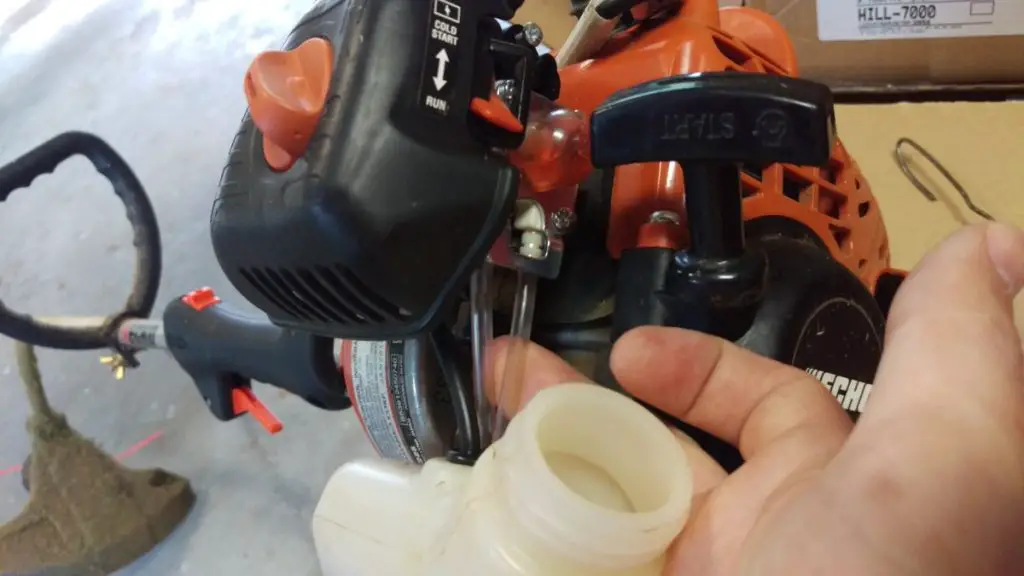The Echo Weed Eater is a powerful tool that can simplify yard maintenance tasks. Whether you’re a professional landscaper or a homeowner looking to keep your lawn in top shape, knowing how to start your Echo Weed Eater correctly is essential. In this step-by-step guide, I will walk you through starting your Echo Weed Eater like a pro, ensuring that you can easily tackle your yard work.
How to Start Your Echo Weed Eater
Starting your Echo Weed Eater may seem daunting initially, but with these simple steps, you can do it like a pro in no time.
Step 1: Prepare the Weed Eater
Before starting your Echo Weed Eater, it’s important to ensure it is properly prepared. First, make sure you have enough fuel in the tank. It is recommended to use high-quality gasoline mixed with a two-stroke engine oil. Next, check the spark plug to ensure it is clean and in good condition. If it’s worn out or dirty, replace it. Additionally, inspect the air filter and clean or replace it if necessary. Finally, check the cutting head and trimmer line to ensure they are in good working order.
Step 2: Prime the Engine
Locate the primer bulb on your Echo Weed Eater to prime the engine. Press the bulb several times until the fuel moves through the clear lines. This helps ensure the engine is properly lubricated and ready to start. Priming the engine is especially important if the machine has been idle for a while.
Step 3: Set the Choke and Throttle
Once the engine is primed, it’s time to set the choke and throttle. Locate the choke lever on your Echo Weed Eater and move it to the closed position. This helps to enrich the fuel mixture, making it easier to start the engine. Next, set the throttle to the “Start” position. This will allow the engine to idle smoothly when you start it.
Step 4: Pull the Starter Cord
It’s time to start the engine with the choke and throttle properly set. Hold the Weed Eater firmly with both hands and place your foot on the cutting head for stability. Then, give a quick, steady pull on the starter cord. The engine should start up smoothly. If it doesn’t start on the first try, repeat the process until it does.
Step 5: Warm Up and Adjust
After successfully starting your Echo Weed Eater, allow it to warm up for a few minutes. This will ensure that the engine reaches its optimal operating temperature. While it’s warming up, listen for any unusual noises or vibrations, as this may indicate a problem that needs to be addressed. If everything sounds and feels normal, you can adjust the choke and throttle to the desired settings for your specific task.
Maintenance tips for keeping your Echo Weed Eater in top shape
Proper maintenance is key to keeping your Echo Weed Eater in top shape. Here are a few tips to help you prolong the life of your machine and ensure optimal performance.
Regular Cleaning
After each use, take the time to clean your Echo Weed Eater. Remove any debris, grass clippings, or dirt that may have accumulated on the cutting head, air filter, or engine. Use a soft brush or compressed air to clean hard-to-reach areas. Regular cleaning prevents clogs and ensures that your Weed Eater continues to operate smoothly.
Fuel Management
Using the right fuel mixture is crucial for the performance and longevity of your Echo Weed Eater. Always use high-quality gasoline mixed with two-stroke engine oil, following the manufacturer’s recommendations. Avoid using old or stale fuel, as it can lead to engine problems. Also, never leave fuel in the tank for extended periods, as it can cause fuel system issues. If you anticipate not using your Weed Eater for a while, drain the fuel tank and run the engine until it stops to prevent fuel-related problems.
Regular Inspections
Regularly inspect your Echo Weed Eater for any signs of wear or damage. Check the cutting head, trimmer line, and spark plug for signs of wear and replace them if necessary. Inspect the fuel lines, air filter, and other components for any signs of damage or deterioration. By catching and addressing these issues early on, you can prevent more significant problems.
My Opinion
Following this step-by-step guide, you can confidently start your Echo Weed Eater like a pro. Prepare your Weed Eater properly, prime the engine, set the choke and throttle, pull the starter cord, and warm up before adjusting the settings. Additionally, maintaining your Echo Weed Eater by regularly cleaning it, managing the fuel properly, and conducting regular inspections will ensure that it stays in top shape and performs optimally for years. With these tips, you’ll be well on your way to mastering the art of starting your Echo Weed Eater.




